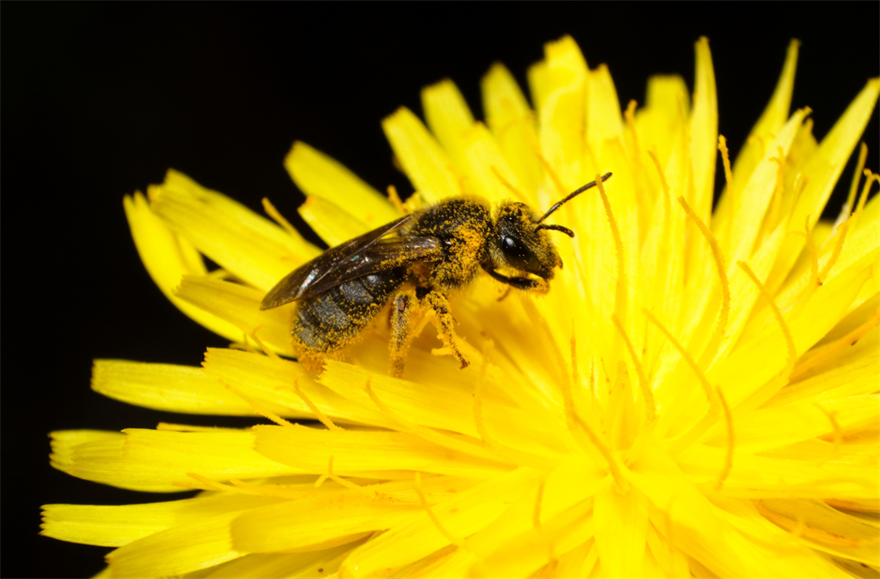Native Bees

Bees play a vital role in pollinating our native plants, gardens and food crops. Bee communities are under threat worldwide and bee numbers are decreasing. However, native bees are not being impacted by the diseases and pests that are affecting the Apis honeybees. Land clearing and habitat fragmentation and people mistaking bees for flies are key threats to native bee populations.
Facts about Bees:
- Australia has over 1,500 species of native bees
- The Sydney region has around 200 species of native bees
- Native bees can be between 2mm and 24mm long
- Native bees can be black, yellow, red, metallic green or even black with blue bands
- Most native bees are solitary; only 10 species live in a social hiv
- One female solitary bee mates and then builds a nest for her eggs. For most species the larvae are sealed up and remain inside the nest over winter and emerge as adults in spring
• Some solitary species found in Sydney include: Reed Bee (Exoneura), Blue Banded Bees (Amegilla), Teddy Bear Bees (Amegilla) and Leafcutter Bees (Magachile)
- 70% of solitary species live in dry earth nests
- Social native bees are stingless (all other species can sting)
- Tetragonula carbonaria is the only species of social bee native to the Sydney region.
Native Stingless Bees Tetragonula carbonaria
The Tetragonula carbonaria hive has a community of between 6,000 and 10,000 bees. The hive structure is similarly spiral-shaped to that of the Apis honeybee, including a queen (lays up to 400 eggs a day), 1,000s of female workers (live average 3 to 4 weeks) and few 100 male drones (after mating with the queen die). The workers play a key role in the health of a hive – scouting for food, collecting pollen, building the brood and guarding the hive. Tetragonula carbonaria bees are active in a temperature range of 18-40 degrees. Each day they travel up to ½ km to source food, compared to Apis honeybees that travel 5-10km.
Honey
Solitary bees collect tiny amounts of nectar to feed their young but do not store honey in their nests. Social bees such as Tetragonula carbonaria produce a small amount of honey that is stored in clusters of resin pots near the extremities of the nest. They use much of this honey themselves as an energy source to survive through winter. Native bee honey, called Sugarbag, was prized by Aboriginal people who collected it from wild hives. A stingless native bee hive produces up to ½kg of honey a year as opposed to the Apis honeybee hive that produces around 20-25kg per year.
How you can help
- Plant a garden that supports native bee species. Good food plants for native bees include Angophora, Eucalyptus, Grevilleas, Leptospermum, Hardenbergia, Acacia and Westringia species. Also let some of your herbs and vegetables go to flower.
- Keep insecticide use to a minimum (if using insecticides use them when bees are less likely to be moving around e.g. the coldest part of the day or night). Encouraging diversity will help naturally keep outbreaks of pests under control.
- Place a hive of native stingless bees in your backyard. There is a list of suppliers for Sydney native bee hives on http://www.aussiebee.com.au/. Ku-ring-gai Council also offers native bee hives for sale. A native bee hive can be observed at the Henley Green Community Garden and The Habitat Community Nursey at Santa Rosa Park, 251 Quarry Road, Ryde.
- Provide artificial nest sites e.g. tie a bunch of hollowed out sticks in a bundle and hang under a branch horizontally in a sheltered spot which receives sun for Reed Bees; drill holes in a piece of old hardwood timber for Resin Bees and Leafcutter Bees; leave a bare patch of earth under the eaves or a pile of old sticks, leaves and branches in a quiet corner of the garden.
- Reed Bees love nesting in the dead canes of lantana – check for nests before removing weeds.
For more information
Pesticide Free Factsheet
We wish to acknowledge Ku-ring-gai Council and Lane Cove Council for the information in this webpage.